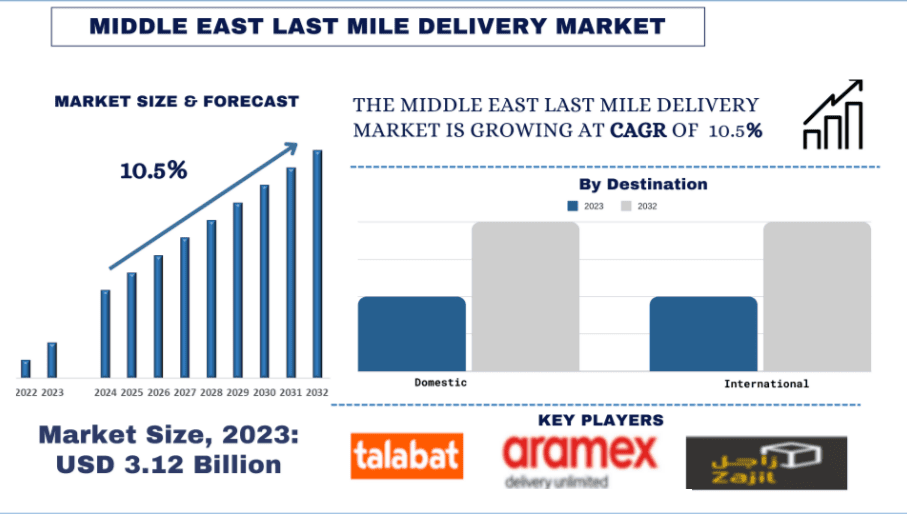- Home
- About Us
- Industry
- Services
- Reading
- Contact Us
Middle East Last Mile Delivery Market: Current Analysis and Forecast (2024-2032)
Emphasis on Destination (Domestic and International); Service Type (Business-To-Business (B2B), Business-To-Consumer (B2C), and Customer-To-Customer (C2C); Delivery Mode (Regular Delivery and Same-Day Delivery or Express Delivery); Application (E-Commerce, Retail and FMCG, Healthcare, Mails and Packages, and Others); Vehicle Type (Motorcycle, LCV, HCV, and Drones); Mode of Operation (Non- Autonomous and Autonomous); Country.
Middle East Last Mile Delivery Market Size & Forecast
The Middle East Last Mile Delivery Market was valued at USD 3.12 Billion in 2023 and is expected to grow at a robust CAGR of around 10.5% during the forecast period (2024-2032).
Middle East Last Mile Delivery Market Analysis
Last-mile delivery is the final stage of the delivery process, where goods are transported from a distribution center or hub to the end destination, which is typically a residential or commercial address. It is called the “last mile” because it represents the final and often most challenging leg of the delivery journey. This stage is critical as it directly impacts customer satisfaction and can be the supply chain’s most expensive and time-consuming part. Last-mile delivery is essential in e-commerce, where customers expect fast and reliable delivery of their online purchases.
The Middle East Last Mile Delivery Market is expected to grow at a strong CAGR of 10.5% during the forecast period owing to increasing government support. For example, in Saudi Arabia, the government has launched initiatives such as Vision 2030, which aims to diversify the economy and promote the growth of the e-commerce sector. These initiatives include investments in infrastructure development, such as improving road networks and implementing smart city technologies, which are expected to drive the growth of the last-mile delivery market in the region. Additionally, governments across the Middle East are introducing regulations to support the e-commerce sector, which is expected to further boost the demand for last mile delivery services.

The Middle East Last Mile Delivery Market Segmentation
Based on Destination, the Middle East Last Mile Delivery Market is segmented into Domestic and International. The domestic segment held the dominant share of the market in 2023. This dominance can be attributed to the growing trend of online shopping within the region, driven by increasing internet penetration and the convenience offered by e-commerce platforms. For example, countries like the UAE and Saudi Arabia have witnessed a significant increase in online shopping activities, leading to higher demand for domestic last-mile delivery services.
By Service Type, the Middle East Last Mile Delivery Market is segmented into Business-To-Business (B2B), Business-To-Consumer (B2C), and Customer-To-Customer (C2C). The Business-To-Consumer (B2C) segment held the dominant market share in 2023. This can be attributed to the rise of e-commerce platforms catering to individual consumers, which has increased the volume of B2C deliveries. Additionally, the convenience of online shopping and the availability of multiple delivery options have contributed to the growth of the B2C last-mile delivery market in the Middle East.
Based on Delivery Mode, the Middle East Last Mile Delivery Market is segmented into Regular Delivery and Same-Day Delivery or Express Delivery. The Regular Delivery segment held the dominant share of the market in 2023. This can be attributed to the fact that regular delivery services are more commonly used and are often more cost-effective for both businesses and consumers. However, with the increasing demand for faster delivery times, the same-day delivery segment is expected to proliferate in the coming years.
By Application, the Middle East Last Mile Delivery Market is segmented into E-Commerce, Retail and FMCG, Healthcare, Mails and Packages, and Others. The E-Commerce segment held the dominant share of the market in 2023. This can be attributed to the rapid growth of the e-commerce sector in the region, driven by factors such as increasing smartphone penetration, rising disposable incomes, and the convenience of online shopping. E-commerce companies are increasingly focusing on improving their last-mile delivery services to meet customer expectations and gain a competitive edge in the market.
Saudi Arabia held a dominant share of the market in 2023
Saudi Arabia held a dominant share of the market in 2023. This dominance can be attributed to several factors, including the country’s large population, high internet penetration rate, and strong government support for the e-commerce sector. For example, Saudi Arabia’s Vision 2030 initiative aims to transform the country’s economy and society, focusing on enhancing the e-commerce ecosystem. As a result, Saudi Arabia has seen significant investments in infrastructure development, such as new roads and logistics hubs, which have contributed to the growth of the country’s last-mile delivery market. Additionally, the rising demand for online shopping and the increasing number of e-commerce players in Saudi Arabia has further fueled the growth of the country’s last-mile delivery industry.

Middle East Last Mile Delivery Industry Overview
The Middle East Last Mile Delivery Market is competitive and fragmented, with the presence of several regional and international market players. The key players are adopting different growth strategies to enhance their market presence, such as partnerships, agreements, collaborations, new product launches, geographical expansions, and mergers and acquisitions. Some major players operating in the market include Aramex, Fetchr, Talabat, Zajil Express, HungerStation, Marsool, Tawseel, Wadi, Carriage, and Mrsool.
Middle East Last Mile Delivery Market News
- In 2019, Aramex launched Aramex Spot, a new service point network designed to enhance last-mile delivery solutions by offering more convenient pick-up and drop-off locations for customers.
Middle East Last Mile Delivery Market Report Coverage
Report Attribute | Details |
Base year | 2023 |
Forecast period | 2024-2032 |
Growth momentum | Accelerate at a CAGR of 10.5% |
Market size 2023 | USD 3.12 Billion |
Major contributing region | Saudi Arabia is expected to grow at the highest CAGR during the forecasted period |
Key countries covered | UAE, Saudi Arabia, Egypt, Iran, Rest of Middle East |
Companies profiled | Aramex, Fetchr, Talabat, Zajil Express, HungerStation, Marsool, Tawseel, Wadi, Carriage, and Mrsool. |
Report Scope | Market Trends, Drivers, and Restraints; Revenue Estimation and Forecast; Segmentation Analysis; Demand and Supply Side Analysis; Competitive Landscape; Company Profiling |
Segments Covered | By Destination; By Service Type; By Delivery Mode; By Application; By Vehicle Type, By Mode of Operation, By Region/Country |
Reasons to buy this report:
- The study includes market sizing and forecasting analysis validated by authenticated key industry experts.
- The report presents a quick review of overall industry performance at one glance.
- The report covers an in-depth analysis of prominent industry peers with a primary focus on key business financials, product portfolios, expansion strategies, and recent developments.
- Detailed examination of drivers, restraints, key trends, and opportunities prevailing in the industry.
- The study comprehensively covers the market across different segments.
- Deep dive regional level analysis of the industry.
Customization Options:
The Middle East Last Mile Delivery Market can further be customized as per the requirement or any other market segment. Besides this, UMI understands that you may have your own business needs, hence feel free to connect with us to get a report that completely suits your requirements.
Table of Content
Research Methodology for the Middle East Last Mile Delivery Market Analysis (2024-2032)
Analyzing the historical market, estimating the current market, and forecasting the future market of the Middle East Last Mile Delivery Market were the three major steps undertaken to create and analyze the adoption of Middle East Last Mile Delivery in major countries. Exhaustive secondary research was conducted to collect the historical market numbers and estimate the current market size. Secondly, to validate these insights, numerous findings and assumptions were taken into consideration. Moreover, exhaustive primary interviews were also conducted, with industry experts across the value chain of the Middle East Last Mile Delivery Market. Post assumption and validation of market numbers through primary interviews, we employed a top-down/bottom-up approach to forecasting the complete market size. Thereafter, market breakdown and data triangulation methods were adopted to estimate and analyze the market size of segments and sub-segments of the industry pertains to. Detailed methodology is explained below:
Analysis of Historical Market Size
Step 1: In-Depth Study of Secondary Sources:
Detail secondary study was conducted to obtain the historical market size of the Middle East Last Mile Delivery Market through company internal sources such as annual reports & financial statements, performance presentations, press releases, etc., and external sources including journals, news & articles, government publications, competitor publications, sector reports, third-party database, and other credible publications.
Step 2: Market Segmentation:
After obtaining the historical market size of the Middle East Last Mile Delivery Market, we conducted a detailed secondary analysis to gather historical market insights and share for different segments & sub-segments for major regions. Major segments are included in the report as destination, service type, delivery mode, application, vehicle type, mode of operation. Further country-level analyses were conducted to evaluate the overall adoption.
Step 3: Factor Analysis:
After acquiring the historical market size of different segments and sub-segments, we conducted a detailed factor analysis to estimate the current market size of the Middle East Last Mile Delivery Market. Further, we conducted factor analysis using dependent and independent variables such as destination, service type, delivery mode, application, vehicle type, mode of operation of the Middle East Last Mile Delivery Market. A thorough analysis was conducted for demand and supply-side scenarios considering top partnerships, mergers and acquisitions, business expansion, and product launches in the Middle East Last Mile Delivery Market.
Current Market Size Estimate & Forecast
Current Market Sizing: Based on actionable insights from the above 3 steps, we arrived at the current market size, key players in the Middle East Last Mile Delivery Market, and market shares of the segments. All the required percentage shares split, and market breakdowns were determined using the above-mentioned secondary approach and were verified through primary interviews.
Estimation & Forecasting: For market estimation and forecast, weights were assigned to different factors including drivers & trends, restraints, and opportunities available for the stakeholders. After analyzing these factors, relevant forecasting techniques i.e., the top-down/bottom-up approach were applied to arrive at the market forecast for 2032 for different segments and sub-segments across the major markets. The research methodology adopted to estimate the market size encompasses:
- The industry’s market size, in terms of revenue (USD) and the adoption rate of the Middle East Last Mile Delivery Market across the major markets domestically
- All percentage shares, splits, and breakdowns of market segments and sub-segments
- Key players in the Middle East Last Mile Delivery Market in terms of products offered. Also, the growth strategies adopted by these players to compete in the fast-growing market
Market Size and Share Validation
Primary Research: In-depth interviews were conducted with the Key Opinion Leaders (KOLs) including Top Level Executives (CXO/VPs, Sales Head, Marketing Head, Operational Head, Regional Head, Country Head, etc.) across major regions. Primary research findings were then summarized, and statistical analysis was performed to prove the stated hypothesis. Inputs from primary research were consolidated with secondary findings, hence turning information into actionable insights.
Split of Primary Participants

Market Engineering
The data triangulation technique was employed to complete the overall market estimation and to arrive at precise statistical numbers for each segment and sub-segment of the Middle East Last Mile Delivery Market. Data was split into several segments & sub-segments post studying various parameters and trends in the areas of the destination, service type, delivery mode, application, vehicle type, mode of operation in the Middle East Last Mile Delivery Market.
The main objective of the Middle East Last Mile Delivery Market Study
The current & future market trends of the Middle East Last Mile Delivery Market were pinpointed in the study. Investors can gain strategic insights to base their discretion for investments on the qualitative and quantitative analysis performed in the study. Current and future market trends determined the overall attractiveness of the market at a country level, providing a platform for the industrial participant to exploit the untapped market to benefit from a first-mover advantage. Other quantitative goals of the studies include:
- Analyze the current and forecast market size of the Middle East Last Mile Delivery Market in terms of value (USD). Also, analyze the current and forecast market size of different segments and sub-segments.
- Segments in the study include areas of the destination, service type, delivery mode, application, vehicle type, mode of operation.
- Define and analysis of the regulatory framework for the Middle East Last Mile Delivery
- Analyze the value chain involved with the presence of various intermediaries, along with analyzing customer and competitor behaviors of the industry.
- Analyze the current and forecast market size of the Middle East Last Mile Delivery Market for the major countries.
- Company profiles of the Middle East Last Mile Delivery Market and the growth strategies adopted by the market players to sustain in the fast-growing market
- Deep dive country level analysis of the industry
Frequently Asked Questions FAQs
Q1: What is the current market size and growth potential of the Middle East Last Mile Delivery Market?
Q2: What are the driving factors for the growth of the Middle East Last Mile Delivery Market?
Q3: Which segment has the largest share of the Middle East Last Mile Delivery Market by destination?
Q4: What are the emerging technologies and trends in the Middle East Last Mile Delivery Market?
Q5: Which country will dominate the Middle East Last Mile Delivery Market?
Related Reports
Customers who bought this item also bought











